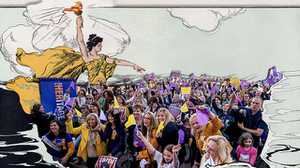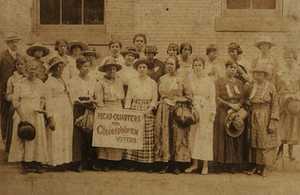Colorizing Suffrage
Renowned photographic colorist Marina Amaral and video enhancement expert neural.love reflect on bringing color to the visual record of women’s suffrage.

She Resisted explores the final decade of the women’s suffrage movement through its most powerful images, brought to life with color for the first time. Working with renowned photographic colorist Marina Amaral to meticulously restore color to century-old archival stills, and video enhancement experts neural.love to upscale and colorize archival footage using neural networks, American Experience celebrates the radicality and perseverance of the women who won the vote a century ago.

The series spoke with our project partners about their working processes and how they hope to bring audiences closer to the events and people of the past using color—and perhaps even helping contemporary viewers see that they aren’t so different from us, after all.
Marina Amaral
Research is the first part of the process. In the case of these photographs, the colors of the banners were very important, given that they were very specific and I had to be able to reproduce them accurately. There are a few items that were used in the protests preserved today in museums and archives, and they are a very important source for me. Purple, white and yellow were the predominant colors, and using these items as references, I was able to reproduce colors that were as close as possible to the originals. Once the main objects are identified and colorized there are always still some gaps to fill. That’s when I have to make artistic choices: to be able to colorize the entire image, finally completing the puzzle.

This project really spoke to me on a personal level. As a woman, suffrage is a topic that has always interested me a lot—I knew that in one way or another, directly or indirectly, we owe a lot to these women who risked their lives fighting for a right that now, thanks to them, belongs to all of us. Unfortunately, many people are unaware of how important the women in these photographs were. As an artist, working on a project that touches me so deeply makes the whole process even more enjoyable and fun.

neural.love
When we started this project, our goal was to bring the suffrage experience to life by transforming grainy, flickering, black-and-white footage into a viewing experience on par with modern cinema. By using artificial intelligence in the form of customized neural networks, we were able to fix damage to the original footage, increase the resolution to 4k, enhance the frame rate to make movements appear more realistic, and add approximate color to each scene.
All of these changes dramatically impact how viewers engage with the source material. Color brings life to the exuberant faces of women getting to vote for the first time.
At the same time, enhanced resolution and frame rates let us experience—not just approximate—the sense of solidarity and strident determination evidenced by a sea of suffragists marching down a New York street or the thunderous applause which accompanies a fiery speech on basic human rights.
It is our hope that although the process of enhancement relies on artificial intelligence, the feeling that it engenders, like the history it represents, will inspire genuine admiration.







